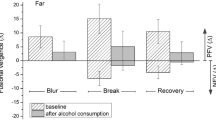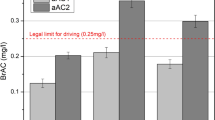Abstract
Purpose
The purpose of this work was to evaluate possible changes in accommodation dynamics caused by the intake of different doses of alcohol.
Methods
A total of 20 emmetropic subjects took part in the study. This involved a baseline session, a session after consuming 300 ml of red wine, and another after consuming 450 ml of the same wine. The accommodation dynamics were characterized for two target vergences (2.5D and 5.0D) using the Grand Seiko WAM-5500 autorefractor, which provided the accommodation and disaccommodation variables. The accommodative facility was measured using flippers of ± 2.00 D.
Results
The mean accommodation velocities and velocity peaks were significantly lower after consuming alcohol for the higher intake, particularly for 5.0D (p < 0.05). The response time was significantly higher only for the high-intake condition for 5.0D (p < 0.05). The accommodative microfluctuations were significantly higher for both target vergences for the high-intake condition (p < 0.05). The accommodative facility was significantly impaired in both intake conditions (p < 0.05). The breath alcohol content (BrAC) was correlated with the deterioration of some variables: the accommodative facility (ρ = 0.490), and the velocity peak for 2.5D (ρ = 0.349) and 5.0D (ρ = 0.387).
Conclusions
Alcohol intake affects accommodation dynamics, causing deterioration in the mean velocity, velocity peak, response time, accommodative microfluctuations, and accommodative facility, especially for the target vergence of 5.0D and high alcohol dosages.



Similar content being viewed by others
Availability of data and materials
Available from the corresponding author on reasonable request.
References
Myers GA, Stark L (1990) Topology of the near response triad. Ophthalmic Physiol Opt 10(2):175–181. https://doi.org/10.1111/j.1475-1313.1990.tb00972.x
Sterner B, Abrahamsson M, Sjostrom A (2001) The effects of accommodative facility training on a group of children with impaired relative accommodation - a comparison between dioptric treatment and sham treatment. Ophthalmic Physiol Opt 21(6):470–476. https://doi.org/10.1046/j.1475-1313.2001.00615.x
Heron G, Charman WN, Gray LS (1999) Accommodation responses and ageing. Invest Ophthalmol Vis Sci 40(12):2872–2883
Thiagarajan P, Ciuffreda KJ (2013) Visual fatigue and accommodative dynamics in asymptomatic individuals. Optom Vis Sci 90(1):57–65. https://doi.org/10.1097/OPX.0b013e31827a233e
Del Aguila-Carrasco AJ, Esteve-Taboada JJ, Papadatou E et al (2017) Amplitude, latency, and peak velocity in accommodation and disaccommodation dynamics. Biomed Res Int 2017:2735969. https://doi.org/10.1155/2017/2735969
Scialfa CT, Garvey PM, Tyrrell RA, Leibowitz HW (1992) Age-differences in dynamic contrast thresholds. J Gerontol 47(3):P172–P175. https://doi.org/10.1093/geronj/47.3.P172
Andre JT (1996) Visual functioning in challenging conditions: Effects of alcohol consumption, luminance, stimulus motion, and glare on contrast sensitivity. J Exp Psychol Appl 2(3):250–269. https://doi.org/10.1037/1076-898x.2.3.250
Heron G, Charman WN, Schor C (2001) Dynamics of the accommodation response to abrupt changes in target vergence as a function of age. Vis Res 41(4):507–519. https://doi.org/10.1016/s0042-6989(00)00282-0
Miller RJ, Takahama M (1988) Arousal-related changes in dark focus accommodation and dark vergence. Invest Ophthalmol Vis Sci 29(7):1168–1178
Zhai HF, Goss DA, Hammond RW (1993) The effect of caffeine on the accommodative response/accommodative stimulus function and on the response AC/A ratio. Curr Eye Res 12(6):489–499. https://doi.org/10.3109/02713689309001827
Abokyi S, Owusu-Mensah J, Osei KA (2017) Caffeine intake is associated with pupil dilation and enhanced accommodation. Eye (Lond) 31(4):615–619. https://doi.org/10.1038/eye.2016.288
Cohen MM, Alpern M (1969) Vergence and accommodation. VI. The influence of ethanol on the AC/A ratio. Arch Ophthalmol 81(4):518–525. https://doi.org/10.1001/archopht.1969.00990010520010
World Health Organization (2018) Global status report on alcohol and health http://apps.who.int/iris/bitstream/handle/10665/274603/9789241565639-eng.pdf?ua=1 Accessed 10 Jun 2020
Hindmarch I, Bhatti JZ, Starmer GA et al (1992) The effects of alcohol on the cognitive function of males and females and on skills relating to car driving. Hum Psychopharmacol 7(2):105–114. https://doi.org/10.1002/hup.470070205
Levett J, Karras L (1977) Effects of alcohol on human accommodation. Aviat Space Environ Med 48(5):434–437
Hill JC, Toffolon G (1990) Effect of alcohol on sensory and sensorimotor visual functions. J Stud Alcohol 51(2):108–113. https://doi.org/10.15288/jsa.1990.51.108
Miller RJ, Pigion RG, Takahama M (1986) The effects of ingested alcohol on accommodative, fusional, and dark vergence. Percept Psychophys 39(1):25–31. https://doi.org/10.3758/bf03207580
Jaschinski W, Jainta S, Hoormann J et al (2007) Objective vs subjective measurements of dark vergence. Ophthalmic Physiol Opt 27(1):85–92. https://doi.org/10.1111/j.1475-1313.2006.00448.x
Win-Hall DM, Houser J, Glasser A (2010) Static and dynamic accommodation measured using the WAM-5500 autorefractor. Optom Vis Sci 87(11):873–882. https://doi.org/10.1097/OPX.0b013e3181f6f98f
Paton A (2005) ABC of alcohol - Alcohol in the body. Br Med J 330(7482):85–87. https://doi.org/10.1136/bmj.330.7482.85
Luczak SE, Rosen IG (2014) Estimating BrAC from transdermal alcohol concentration data using the BrAC estimator software program. Alcohol Clin Exp Res 38(8):2243–2252. https://doi.org/10.1111/acer.12478
Castro JJ, Ortiz C, Pozo AM et al (2014) A visual test based on a freeware software for quantifying and displaying night-vision disturbances: study in subjects after alcohol consumption. Theor Biol Med Model 11(Suppl 1):S1. https://doi.org/10.1186/1742-4682-11-S1-S1
Castro JJ, Pozo AM, Rubino M et al (2014) Retinal-image quality and night-vision performance after alcohol consumption. J Ophthalmol 2014:704823. https://doi.org/10.1155/2014/704823
Jones AW, Andersson L (2003) Comparison of ethanol concentrations in venous blood and end-expired breath during a controlled drinking study. Forensic Sci Int 132(1):18–25. https://doi.org/10.1016/s0379-0738(02)00417-6
Jones A (2010) The relationship between blood alcohol concentration (BAC) and breath alcohol concentration (BrAC): a review of the evidence. Road Safety Web Publication No. 15. Department for Transport, London. https://webarchive.nationalarchives.gov.uk/20120215031305/http://www2.dft.gov.uk//pgr/roadsafety/research/rsrr/theme3/report15.pdf Accessed 18 Sept 2020.
Sheppard AL, Davies LN (2010) Clinical evaluation of the Grand Seiko Auto Ref/Keratometer WAM-5500. Ophthalmic Physiol Opt 30(2):143–151. https://doi.org/10.1111/j.1475-1313.2009.00701.x
Chen YY, Jin WQ, Zheng ZL et al (2017) Comparison of three monocular methods for measuring accommodative stimulus-response curves. Clin Exp Optom 100(2):155–161. https://doi.org/10.1111/cxo.12469
Schor CM, Kotulak JC (1986) Dynamic interactions between accommodation and convergence are velocity sensitive. Vis Res 26(6):927–942. https://doi.org/10.1016/0042-6989(86)90151-3
Schor CM, Alexander J, Cormack L et al (1992) Negative feedback-control model of proximal convergence and accommodation. Ophthalmic Physiol Opt 12(3):307–318. https://doi.org/10.1111/j.1475-1313.1992.tb00403.x
Armstrong RA (2013) Statistical guidelines for the analysis of data obtained from one or both eyes. Ophthalmic Physiol Opt 33(1):7–14. https://doi.org/10.1111/opo.12009
Charman WN, Heron G (1988) Fluctuations in accommodation - a review. Ophthalmic Physiol Opt 8(2):153–164. https://doi.org/10.1111/j.1475-1313.1988.tb01031.x
Aldaba M, Gomez-Lopez S, Vilaseca M et al (2015) Comparing autorefractors for measurement of accommodation. Optom Vis Sci 92(10):1003–1011. https://doi.org/10.1097/opx.0000000000000685
Redondo B, Vera J, Luque-Casado A et al (2019) Associations between accommodative dynamics, heart rate variability and behavioural performance during sustained attention: a test-retest study. Vis Res 163:24–32. https://doi.org/10.1016/j.visres.2019.07.001
Poltavski DV, Biberdorf D, Petros TV (2012) Accommodative response and cortical activity during sustained attention. Vis Res 63:1–8. https://doi.org/10.1016/j.visres.2012.04.017
Zellers JA, Alpert TL, Rouse MW (1984) A review of the literature and a normative study of accommodative facility. J Am Optom Assoc 55(1):31–37
Adler P, Scally AJ, Barrett BT (2018) Test-retest reproducibility of accommodative facility measures in primary school children. Clin Exp Optom 101(6):764–770. https://doi.org/10.1111/cxo.12691
World Health Organization (2014) Global status report on alcohol and health 2014. https://apps.who.int/iris/bitstream/10665/112736/1/9789240692763_eng.pdf Accessed 15 Jun 2020.
Koskinen P, Virolainen J, Kupari M (1994) Acute alcohol intake decreases short-term heart rate variability in healthy subjects. Clin Sci 87(2):225–230. https://doi.org/10.1042/cs0870225
Murata K, Araki S, Yokoyama K et al (1994) Autonomic neurotoxicity of alcohol assessed by heart rate variability. J Auton Nerv Syst 48(2):105–111. https://doi.org/10.1016/0165-1838(94)90026-4
Schrieks IC, Stafleu A, Kallen VL et al (2014) The biphasic effects of moderate alcohol consumption with a meal on ambiance-induced mood and autonomic nervous system balance: a randomized crossover trial. PLoS One 9(1):e86199. https://doi.org/10.1371/journal.pone.0086199
Miller RJ, Pigion RG, Martin KD (1985) The effects of ingested alcohol on accommodation. Percept Psychophys 37:407–414. https://doi.org/10.3758/bf03202871
von Helmholtz H (1867) Handbuch der physiologischen Optik. Voss, Leipzig
Temme LA, Morris A (1989) Speed of accommodation and age. Optom Vis Sci 66(2):106–112. https://doi.org/10.1097/00006324-198902000-00008
Winn B, Pugh JR, Gilmartin B et al (1990) Arterial pulse modulates steady-state ocular accommodation. Curr Eye Res 9(10):971–975. https://doi.org/10.3109/02713689009069933
Wilson G, Mitchell R (1983) The effect of alcohol on the visual and ocular motor systems. Aust J Ophthalmol 11(4):315–319. https://doi.org/10.1111/j.1442-9071.1983.tb01099.x
Eisenhofer G, Lambie DG, Johnson RH (1986) Effects of ethanol on cardiovascular and catecholamine responses to mental stress. J Psychosom Res 30(1):93–102. https://doi.org/10.1016/0022-3999(86)90070-x
Vallee A, Gabet A, Deschamps V et al (2019) Relationship between nutrition and alcohol consumption with blood Pressure: the ESTEBAN survey. Nutrients 11(6):1433. https://doi.org/10.3390/nu11061433
Rosito GA, Fuchs FD, Duncan BB (1999) Dose-dependent biphasic effect of ethanol on 24-h blood pressure in normotensive subjects. Am J Hypertens 12(2 Pt 1):236–240. https://doi.org/10.1016/s0895-7061(98)00237-4
Puddey IB, Mori TA, Barden AE et al (2019) Alcohol and hypertension-new insights and lingering controversies. Curr Hypertens Rep 21(10):79. https://doi.org/10.1007/s11906-019-0984-1
Miege C, Denieul P (1988) Mean response and oscillations of accommodation for various stimulus vergences in relation to accommodation feedback-control. Ophthalmic Physiol Opt 8(2):165–171. https://doi.org/10.1111/j.1475-1313.1988.tb01032.x
Owsley C, McGwin G (1999) Vision impairment and driving. Surv Ophthalmol 43(6):535–550. https://doi.org/10.1016/s0039-6257(99)00035-1
Casares-Lopez M, Castro-Torres JJ, Martino F et al (2020) Contrast sensitivity and retinal straylight after alcohol consumption: effects on driving performance. Sci Rep 10:13599. https://doi.org/10.1038/s41598-020-70645-3
Jafarzadehpur E, Aazami N, Bolouri B (2007) Comparison of saccadic eye movements and facility of ocular accommodation in female volleyball players and non-players. Scand J Med Sci Sports 17(2):186–190. https://doi.org/10.1111/j.1600-0838.2005.00535.x
de Oliveira RF, Oudejans RRD, Beek PJ (2009) Experts appear to use angle of elevation information in basketball shooting. J Exp Psychol Hum Percept Perform 35(3):750–761. https://doi.org/10.1037/a0013709
Acknowledgments
We thank Local Police of Granada city (Granada, Spain) and Dräger Iberia (Madrid, Spain) for lending us the breath analyzer, and Pago de Almaraes wineries for providing us with the wine used in the study. We also thank Trágora SCA for reviewing the English version of the manuscript.
Funding
This research was supported by the Ministry of Economy and Competitiveness (Spain) and European Regional Development Fund (ERDF) (FIS2017-85058-R).
Author information
Authors and Affiliations
Contributions
MCL contributed on the design of the study, acquisition and interpretation of data and drafting the article. JJCT contributed on the conception and design of the study, drafting the article and revising and approving the version to be published. SOP carried out the acquisition and interpretation of data and drafted the article. COH carried out the interpretation of data, revising, and approving the version to be published. RGA contributed on the conception of the study and revising the article and approving the version to be published, and was responsible of the funding for this study.
Corresponding author
Ethics declarations
Conflict of interest
All authors certify that they have no affiliations with or involvement in any organization or entity with any financial interest (such as honoraria; educational grants; participation in speakers’ bureaus; membership, employment, consultancies, stock ownership, or other equity interest; and expert testimony or patent-licensing arrangements), or non-financial interest (such as personal or professional relationships, affiliations, knowledge or beliefs) in the subject matter or materials discussed in this manuscript.
Ethical approval and informed consent
Before starting the experiment, the participants gave their informed consent in accordance with the Helsinki declaration (World Medical Declaration of Helsinki, 2001). All the methods and procedures used in the study were approved by the University of Granada Human Research Ethics Committee (Approval number: 921/CEIH/2019).
Additional information
Publisher’s note
Springer Nature remains neutral with regard to jurisdictional claims in published maps and institutional affiliations.
Rights and permissions
About this article
Cite this article
Casares-López, M., Castro-Torres, J.J., Ortiz-Peregrina, S. et al. Changes in accommodation dynamics after alcohol consumption, for two different doses. Graefes Arch Clin Exp Ophthalmol 259, 919–928 (2021). https://doi.org/10.1007/s00417-020-04978-0
Received:
Revised:
Accepted:
Published:
Issue Date:
DOI: https://doi.org/10.1007/s00417-020-04978-0




